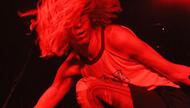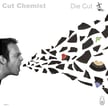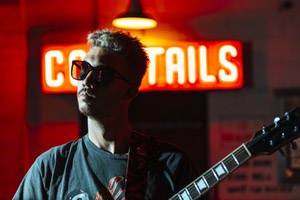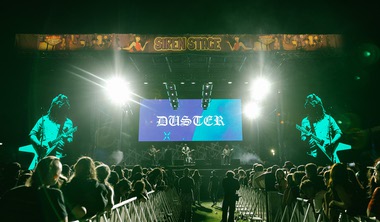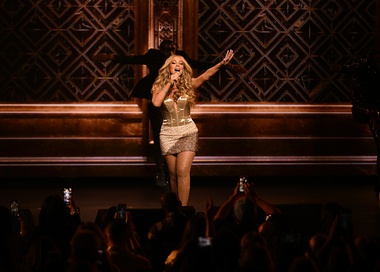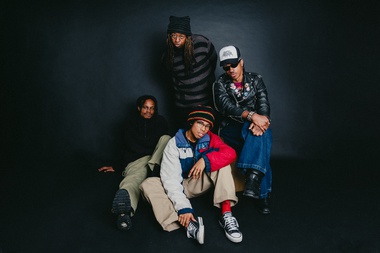Brian Transeau—better known as BT—is expanding his electronic music empire with the synth-pop project All Hail the Silence. His collaboration with Christian Burns—formerly of BBMak and now a solo artist—released its debut, Daggers, earlier this year.
Transeau checked in the day after a show in Cleveland he called All Hail the Silence’s “best show so far” on a tour opening for Howard Jones, who he says is “literally the reason why I wanted … to make music with synthesizers. He is 100 percent [my] inspiration for that.”
What made the show so good? I had a lot of fans there, which is cool and a bit weird for these Howard Jones shows. There’s a real generational divide between Howard’s audience and mine, so we have a lot more people coming up saying, “Oh, I’ve never heard of you guys, but we loved your set and loved hearing you play with Howard.”
[But this time] it was absolutely packed when we went on. People were going nuts and singing back all the words to our songs. We went on later in the night and performed one of the songs that I wrote with Howard for his album, “The One to Love You.” People just went absolutely mental.
My mom and dad came out to a show when we were in New Jersey, and she reminded me that Howard was quite literally the first concert she ever dropped me off at. To be able to be out on these shows with Howard and his wife, Jan, who’s absolutely amazing, and our crew—it’s unlike any other tour I’ve been on. It’s absolutely thrilling. Touring is hard, living on a bus is hard, but we’re having the time of our lives. It’s just a blast.
I’m sure you’ve experienced tours that are not like this. Yeah, I’ve been on tour with Moby and had to step over the drunk sound guy laying in the aisle, and people partying and being thrown off buses. This is all very sensible. Everybody gets on the bus and gets a proper cup of tea and then sits outside on lawn chairs while Howard smokes his cigar and we all sit around and tell stories. It’s like a little family.
Tell me how All Hail the Silence came to be. [Christian and I] were out singing with Tiësto, and we had this instantaneous musical rapport. We grew up thousands of miles away from one another, [but] we grew up listening to the same music— Jean-Michel Jarre and Howard Jones and The Human League.
We started writing together; Christian and I wrote a couple of the songs that are on [BT’s album] These Hopeful Machines, [which] was nominated for a Grammy. We have an incredible, simpatico-type writing aesthetic. There was a moment there—I think Christian was on tour with Armin [van Buuren] in Brazil—and we were texting and I said, “You know, I think this is a band.” He texted back and he’s like, “I think you’re right.”
What drew you to make the new record in an analog fashion? I have a friend who’s a synth tech at a local synth shop in Silver Spring, Maryland. He is the biggest collector of analog synths I’ve ever met in my life—which is really saying something coming from me, because I have a ton of analog synths myself. He’s never let anyone record at his house, and I understand why, because he has all these things that are so extraordinarily valuable.
Anyway, I begged and pleaded for a long time. We wanted to make a record the way that our heroes made records—Tears for Fears, Howard, Yaz, all the Vince Clarke projects, early Depeche [Mode], New Order, Cabaret Voltaire, The Blue Nile. That meant using all of these beautiful vintage analog instruments—analog modular synthesizers—and really doing these bespoke, compositional things from scratch.
So many people now take for granted that you can have a laptop and a DAW [digital audio workstation] and some good plug-ins and you can make a record and upload it to Beatport, Apple Music and Spotify. Then if you’re good enough at it, six months later you can be somebody like a Martin Garrix or Madeon and you can find yourself playing main stage at Ultra. All that’s wonderful, and I love how things have evolved, [but] that’s the exact opposite to the aesthetic that we really wanted to embrace for this.
We used no computers in the making of this record. Everything is recorded from analog instruments directly to tape, and the automation was our own hands and sometimes feet. My belief is that part of what’s so special about those records is how hard they were to make. They had to mean it to make it.
We wrote this batch of songs that really deserved this kind of treatment, and we spent all our own money and time and effort and blood, sweat and tears to make this record in a way that we felt adhered to the doctrine of our heroes. It really was a passion project that’s a complete labor of love.
There’s such a sense of accomplishment when you do something from start to finish. And there’s something to be said about making music with your own hands. Instead of just painting something, it’s like, “I’m going to need to go cut down a small tree, because I’ve got to build an easel. And then I need some berries to make pigments for my paint.” It was like that. I sat with patch cables around my neck, and I would be standing at a modular synthesizer taller than I am. I’d sit there for four hours, and I would patch cable together with a kick drum. It had to be 110 degrees in that room—it’s in the basement of Jeff’s house. It’s floor-to-ceiling synthesizers everywhere you look. Then I’d step over three feet and spend the next three or four hours patching together a snare drum.
It’s funny, because young producers, even guys that I mentor and people that I collaborate with regularly in the dance-music space, are mystified by this. They cannot wrap their head around why you would go to such effort to make something. It takes a lot to make something that stands the test of time, and I think there’s no better way to do that than to create all of it with your own hands.
How did you grow as a musician and as a composer from making the music that way? What I do for “a living” is score films and score television shows. Of course, I still do a lot of stuff in the electronic dance music space and in trance and collaborations. Then, as a side thing, I make all this crazy music software that people use on all different kinds of things. Recently we found out they used Stutter Edit in Star Wars and Stranger Things, which kind of blew my mind.
Anyway, those are my three main things. As it relates to this project, I found myself really pushing into a different space than I usually am [in] when I’m working. So much of my nonperformance work—if I’m not out playing or conducting an orchestra, which happens three times a year—is stationary. I have a lift desk, but even still I’m at a desk with a computer and a barrage of synthesizers, and I’m composing. What was so freeing and wonderful about this project is I found myself listening more than looking.
That sounds a little abstract, but I can explain it. When I’m behind a computer, you’re looking at all these linear time lines, and you’re following what’s happening in a composition, and you play it, but you go back and you’re drawing in things, like, “Oh, we need a volume swell here,” “The reverb needs to be accentuated in this part” or “This needs to be EQ’d over time.” You’re looking at it. What I found myself doing with the All Hail the Silence stuff was listening. It was this incredible, revelatory experience. Listening and using my hands, too. Instead of drawing something on the computer, I could grab a knob and physically do it.
And, furthermore, I had to think about when I’m doing it and with what sort of ferocity and over what period of time. It’s like playing an instrument, playing a console like it’s an instrument, playing effects like they’re instruments or playing synth live to tape.
It reminded me of being a teenager, before I had the ability to do all these things in the DAW. I’ve really reverse-incorporated that into my workflow. I have a lot of vintage and new modular synthesizers in my studio. Now I find myself using them in a way that I wouldn’t before, which is this very physical way, like playing them as an instrument, which they are. And listening instead of looking. That’s a big bottleneck that I broke through. It’s a real growth point in this process for me.
What’s it been like touring and performing with Christian? Christian is just an awesome human being. I have a kind of “must be able to break bread with” policy for people that I work with. I mean, the amount of films I’ve turned down because someone’s reputation precedes them, or I’ve rubbed shoulders with them and they may not remember it, is kind of laughable at this point. Christian is an inspiring, positive, outgoing, kind, loyal, great guy. I love spending time with him totally unrelated to music stuff.
As a musician, I think the thing that really leaps out to me about Christian’s gift is his phenomenal voice. He’s just an incredible singer. Every night after the shows, Howard’s coming up to him and going, “Christian, you sound Auto-Tuned.” Christian’s like, “I’m just straight out to the front-of-house.” He has such great intonations. I love his melodic sensibility, and his lyrics are just unbelievable. The way he can take a really simple idea and turn it into something that’s haunting and stays with you—a lyric like “Diamonds in the Snow,” about something that’s really beautiful and elegant being overlooked. It’s a simple metaphor, but it’s so poignant and powerful.
And he’s an amazing performer. I’m a bit of a lunatic onstage, terrifying everyone with my throwing-my-keyboards-around antics, so we’re well-suited to be onstage together. I think it’s a lot of fun for people to watch us.
I know that you’re a fan of OMD. Andy McCluskey does his contortions and dances onstage. The stuff that I grew up on—even the synth music—the people were performers. I was playing in punk and ska bands when I was a kid before I went to Berklee [College of Music]. Although I have this classical upbringing, my real musical education for what I do now is this real, punk rock band aesthetic. I’ve been at electronic music events where you see people that are just really stoic. They call it, with DJs, checking their email.
I grew up watching and idolizing such amazing performers, like Dave Gahan or Martin Gore [of Depeche Mode] … [and] Orchestral Manoeuvres [in the Dark]. Howard is a great example of it. Those are the guys and girls I idolized, so I wanted to be like that. Throwing the keyboards all over the place is in keeping with the spirit of my heroes.
Your Movement in Still Life album will turn 20 this fall. Do you have any distinct memories of that period? Something that really stands out to me about Movement in Still Life now: It’s a record that, from a compositional vantage point, I’m still so incredibly proud of. I hear in other producer’s work them referencing it all the time.
It feels really, really great, because I did cross an interesting personal threshold between ESCM, which was my second album and Movement in Still Life. That’s the point where my Stutter Edit technique really congealed, and I was able to do this thing that I had imagined and tried to do with samplers. I was able to do it in a nonlinear editing environment in a DAW, because I had my first thing that I was able to record audio into, instead of just a sampler.
The technique expanded at that point, and from that point through until the early 2000s is when I started my software company, Sonic Architect, and then eventually built out Stutter Edit into a plug-in. It was the infancy of some of these tech ideas that I had that eventually coalesced into actual widgets that people have used in their own creative workflow.
There’s so much that’s special about that record. It’s one of my favorite albums of mine.
You’ve played in Las Vegas quite a bit. Do you have any specific memories of being there? One of my favorite memories would be playing at EDC when my daughter, Kaia, was about 10. Her and my wife actually came out onstage with me. Kaia’s seen some really big crowds, but I think that was one of the first times where it really clicked like, “This is crazy. My dad’s out here doing this, and people are going nuts, and the lights are crazy.” My wife, Lacy, took a really special picture of us out there together, this really candid snapshot of the two of us onstage there together.
ALL HAIL THE SILENCE Opening for Howard Jones, with Men Without Hats. July 13, 8 p.m., $25-$50. The Cub at the Cannery, 702-507-5700.

